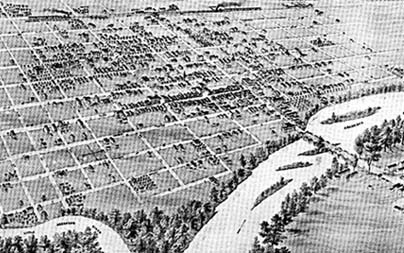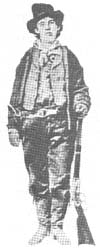|
|
|

 |
Wichita was incorporated as a city of the third class on July 21, 1871. One hundred twenty-three men and one woman signed the original incorporation petition. The woman was Mrs. Catherine McCarty, mother of "Billy the Kid" William Bonney. Later, she moved her family to New Mexico.
|
|
 William Bonney - Billy the Kid |
|
Of course, the first original inhabitants were various tribes of the Plains Indians. Be sure to check my Native Section too :)
|
|
|
Within a year of incorporation, Wichita experienced phenomenal growth, due largely to the cattle trade from Texas. So rapid was the population growth that in late 1872, Wichita became a city of the second class. That same year, Col. Marshal Murdock founded the Wichita City Eagle, today the largest newspaper in the state. |

|
|
|
|
|
Religion, education, and culture followed. The first schoolhouse and the first church shared the same structure, a rough-hewn building of cottonwood slabs with a sod roof. By the end of the first decade, several more schoolhouses were constructed and teachers hired. The first public library was established in 1878. |
|
|
Entertainment in early Wichita was of the raucous kind, occurring mostly in saloons and card houses. The young city even boasted a "variety" theater which featured female entertainers most noted for their lack of attire. Gradually, more cultured attractions began to develop. Several local bands and orchestras regularly entertained. Traveling theatrical shows passed through town, including the popular Chautauqua meetings in the late 1800s and early 1900s. (See The Infamous) |
|
Drs. E.B. Allen and A.H. Fabrique set up practices in the city by the middle 1870s. The latter was also responsible for the founding of St . Francis Hospital. Today, Wichita is recognized as a regional medical center offering a full range of services in the healing arts.
Wichita's first college, Garfield University, was founded in 1887 by the Christian Church. The school closed in 1890 and reopened two years later. In 1898, the Friends Church took it over and renamed it Friends University. Today, the school is the largest private college in the state. Fairmount College, boastfully known as "the Vassar of the West," opened in 1892. In 1926, the City of Wichita took over the school, renaming it Wichita University. The institution entered the Kansas Regents system in 1965 and became Wichita State University. Kansas Newman College began as St. John's Academy, a school for Catholic girls, in 1902. Later, a boys school was added. In 1923. the institution became a junior college and 10 years later was expanded to a four-year institution. The name was changed to Sacred Heart College in 1952. In 1973, to reflect a broader scope of education, the name was changed to Kansas Newman College.
Wichita fell on hard times in the late 1870s when the cattle trade moved further west to take advantage of the construction of rail lines. But by 1880, the city had rebounded with a growing economy in agriculture and manufacturing and in the late teens and early 1920s, Wichita became a center for aircraft experimentation and production. Men like Lloyd Stearman, Walter Beech, Clyde Cessna, E. M. Laird, J. M. Mollendick, and George Weaver were responsible for starting the aircraft industry in the area. With Mollendick as the financial backer, Laird started the Swallow Airplane Company to build the Swallow airplane which had been designed in Chicago. Interestingly, Beech, Cessna and Stearman all worked for Laird and Mollendick until each went on to establish his own company. Stearman's company later was purchased by the Boeing Company of Seattle. The Beech and Cessna companies continue today, as does Learjet, founded by William Lear in the mid 1960s.
With the outbreak of World War II, government contracts with airplane companies, especially The Boeing Company, caused a swell in population. While the population boom faded with the end of the war, a steady growth has continued since. Wichita remains an aircraft city but its manufacturing base has diversified into chemicals, electronics, composite materials, electric fans, and a range of outdoor products manufactured by The Coleman Company.
Amusement park rides and transit buses are manufacturer here by Chance Industries Inc. In the 1950s, the Carney Brothers, Frank and Dan, established a small pizza restaurant at the corner of Bluff and Kellogg, financed by a $600 loan from their mother. Pizza Hut is now an international corporation, owned by Pepsico.
Under the leadership of Charles Koch, Koch Industries has experienced tremendous growth, increasing annual revenues from $177 million 30 years ago to nearly $30 billion today. The firm was originally established as the Wood River Oil and Refining Company in 1940 by Fred C. Koch who died in 1968. Upon taking over that year, Charles renamed the firm in honor of his father. Headquartered in Wichita, it is the second largest privately held company in the U.S.
Another major national company founded and headquartered in Wichita is Rent-A-Center, a furniture and appliance rental enterprise with outlets nationwide. Best Western International has its international reservations facility located in the city. A touch of the Old West remains at Sheplers, The World's Largest Western Wear Store. The firm maintains an international catalog division and two retail outlets here. Retail outlets are also located in seven other states.
Source: Kansas State Historical Society
Further Links
Wichita,
KS Western Heritage Tour
CyberGuide to Wichita
Wichita, The Air Capital
| |
|||

Local weather from weather.com
~~~~~~~~~~~~~~~~~~~~~~~~~~~~~~~~~~~~~~~~~~~
Where We Critters Live
Kansas || Wichita
The Plains Indians
The Infamous || Tornado!
~~~~~~~~~~~~~~~~~~~~~
New Hampshire || Lake Winnipesaukee
The Abenaki || Alton Bay
Main
SiteGuide
Avian
Critter || Canine Critter
|| Human Critters
Beanie Critters || Wild
Critters
Interests & Hobbies & Links, Oh My!
~~~~~~~~~~~~~~~~~~~~~~~~~~~~~~~~~~~~~~~~~~~